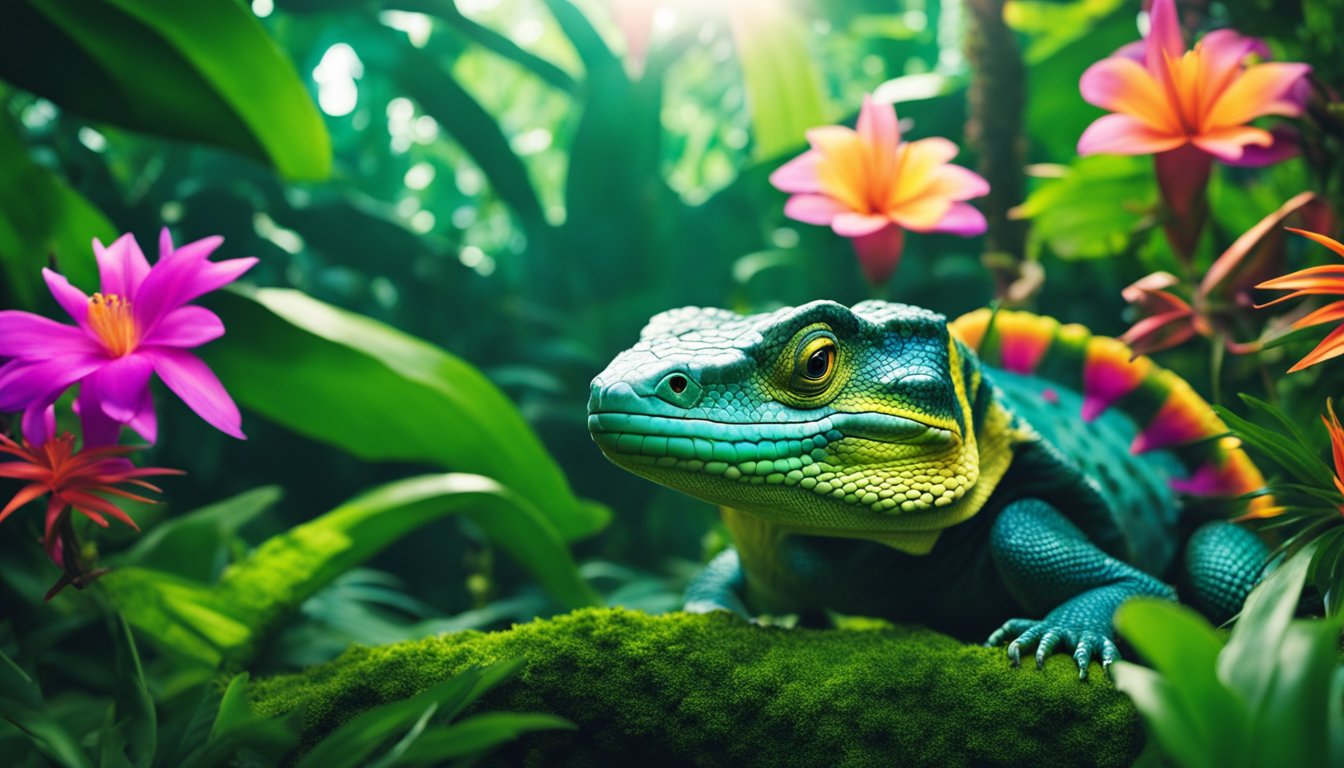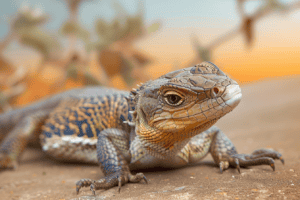Imagine a world alive with a kaleidoscope of colors, where shimmering scales and vivid patterns are the norm.
This world isn’t the stuff of fairy tales—it’s the realm of the reptiles, a fascinating group of animals that boast some of the most brilliant and eye-catching hues on the planet.
From the iridescence of a rainbow boa to the bright blue and red of the Spider-Man Agama, reptiles showcase an unimaginable variety of colors that often rival the most vivid flowers or birds.
These cold-blooded creatures use their colors for all sorts of reasons, from attracting mates to warning predators to stay away.

The animal kingdom is full of wonders and reptiles are some of its most dazzling members.
They slither, they climb, and they inspire awe with their rich tapestries of color. Reptiles are more than just their impressive appearances.
They play vital roles in their ecosystems, as predators and prey, and their colors can tell a story about their survival tactics.
Some reptiles, like the Blue-Tailed Skink, flash a warning sign with their brightly colored tails, while others, such as chameleons, change hues to communicate or blend in with their surroundings.
As we embark on this exploration of the brightest and most colorful reptiles, it’s not just a journey to appreciate their beauty.
It’s a quest to understand how and why they sport such vibrant colors.
These reptiles have adapted over millennia to their environments in extraordinary ways, and their colorful displays serve as a window into evolution’s remarkable creativity.
So let’s dive into the incredible lives of these colorful reptiles and learn what makes them some of the most spectacular animals on Earth.
Diversity of Colorful Reptiles
Reptiles paint the planet with their remarkable colors, ranging from the lush green canopy of the rainforest to the crisp blue of a clear sky.
These creatures boast scales that sparkle with an artist’s palette of hues, serving various roles from camouflage to courtship displays.
Spectrum of Scales: Lizards and Snakes
Lizards and snakes sling a rainbow across their habitats with scales that can shimmer with bright colors.
The blue racer snake, for instance, is known for its vibrant blue hue, which may help it blend into shadows and confuse predators.
Similarly, the frilled lizard sports a mix of colors that allow it to disappear amongst the leaves and bark, protecting it from hungry eyes.
Among lizards, one might find the fire skink with its flames of red and gold, or the blue-tailed skink, with a tail that looks like a piece of the sky fallen to earth.
In contrast, the green thornytail iguana, with its spikes and green color, appears almost as a piece of living foliage, making it less visible to predators while it quietly feeds on leaves.
Lizards like the common collared lizard can be found dashing across rocks, their bright colors a blur to human eyes.
The often kept as pets, leopard geckos and bearded dragons, have spots and patterns that make each individual uniquely beautiful.
These colorful reptiles not only dazzle with their diverse looks but also play a crucial role in ecosystems as both predators and prey.
Chameleons and Geckos: Masters of Color
The panther chameleon and the tokay gecko are like living jewels with their stunning color transformations and striking patterns.
The panther chameleon, in particular, is like a kaleidoscope come to life; it can shift its color to communicate or regulate its body temperature.
This ability to change color is not just for show – it can signal to other chameleons and may help these stunning creatures to catch their next meal or hide from a predator.
Imagine the chameleon’s color changing like the lights of a disco ball, flashing its messages across the leafy dance floor of the forest.
The tokay gecko dons a coat of bold dots and hues, resembling a starry night sky, and can even sing with chirps and barks to court a mate.
They scale walls with ease in search of insects, becoming animated mosaics in the night.
When one spots a spider-man agama, with its red and blue costume-like skin, it’s as if a tiny superhero has leapt out of a comic book and into the wild.
Then there’s the ornate day gecko, which brightens the day with its jewel-like greens and blues, a vivid reminder of nature’s artistry.
These reptiles, from lizards with their variety of color patterns to geckos with their spectacular hues, are not just a delight to observe.
They’re integral to the natural world, adapting to their environments and playing a critical role in the balance of their ecosystems.
Whether catching a glimpse of them in the wild or observing them in captivity, these colorful reptiles continue to fascinate and inspire.
Habitats and Adaptations

Before we embark on a vibrant journey through the habitats of some of the world’s most colorful reptiles, let’s remember how these environments foster their remarkable shades and facilitate their survival.
Rainforests and Deserts: Reptiles in the Wild
The rainforests of Brazil and the dense greenery of Southeast Asia are teeming with life, providing a kaleidoscopic backdrop for species such as the Brazilian rainbow boa and the San Francisco garter snake.
In these lush environments, where the competition for survival is as fierce as the colors are bright, reptiles use their hues to blend in with the vibrant flora.
This camouflage keeps them hidden from predators and helps in ambushing prey.
Descending from trees to land, some reptiles, like the fire skink, found in Central Africa, live amongst leaves and on the forest floor.
They lay their eggs in secure nests woven from the environment’s bounty.
The dampness of the rainforest coupled with the warmth it holds fosters an ideal setting for these eggs to thrive and hatch.
On the other side of the spectrum are deserts in regions such as Northern Mexico and the Southern United States, where the Gila monster resides.
The stark contrast of the desert landscape, with its sweeping sands and austere beauty, presents a unique backdrop for life.
Here, reptiles have evolved with vivacious and warningly vibrant patterns to dissuade predators and to regulate their body temperature, as colors can influence thermal control.
Climatic Impact on Reptilian Colors
Ever wondered why reptiles in different climates show such an array of colors? The climate plays a pivotal role in the colors of these animals.
In Southern China’s mountainous regions or along the coral reefs, where sunlight is a precious commodity or filtered in unique ways, reptiles exhibit colors that can appear incandescent when photographed.
In environments that fluctuate, like those that transition from wet to highly arid, reptiles have adapted by developing color-shifting abilities.
For instance, chameleons and some species of geckos can alter their coloration to reflect their mood, temperature, and light conditions—a stunning display of adaptation.
Reptiles like the rainbow boa have skin that refracts light into a spectrum, an adaptation that not only astounds the observer but also helps them to remain enigmatic within their habitats which are filled with water and dense trees.
This interaction with light and environment accentuates their colors and cements their place as some of the most mesmerizing creatures on the planet.
Throughout these diverse habitats, from water-laden rainforests to the dry expanses of deserts, colorful reptiles thrive.
By studying these creatures and their homes, one gets a glimpse of how dynamic and interconnected life on this planet truly is.
Conservation and Threats

In the kaleidoscope of the animal kingdom, our scaly friends—reptiles—face significant threats, and understanding these dangers is vital for their survival.
Let’s explore what’s happening in their world and how humans are stepping up to protect these colorful creatures.
Endangered Reptiles and Preservation Efforts
The planet’s rainforests are home to a dazzling array of reptiles, from the emerald tree monitor to the golden toad, each more vibrant than the last.
Yet, their bright colors often signal poison, a natural defense against predators that’s as bold as the hues they display.
Despite such defenses, many reptile species are on the brink of extinction due to habitat loss, climate change, and poaching.
One captivating species is the agama lizard; its stunning blue and red colors make it a jewel of the wild.
Similarly, the Psammophilus dorsalis and Calotes versicolor use their extraordinary colors to regulate body temperature and communicate.
Unfortunately, their allure also makes them targets for illegal wildlife trade.
Did you know that a reptile can be endemic to a specific region? This means they are found nowhere else on Earth!
This uniqueness, however, also makes them incredibly vulnerable.
For instance, snakes, with their varied diets of rodents, insects, small mammals, and other snakes, play a crucial role in maintaining the delicate balance of their ecosystems as both predators and prey.
Yet, when their habitats are destroyed, these vital connections are severed.
Conservationists are tirelessly working to ensure these brilliant beings don’t fade away.
They’re creating protective reserves, enforcing anti-poaching laws, and leading breeding programs.
For example, the efforts to save the fish, amphibians, birds, and frogs share a common goal with reptile conservation—safeguarding the rich tapestry of biodiversity.
Through these endeavors, humanity hopes to keep the world’s brightest reptiles not just a memory or image, but living, breathing wonders for generations to witness.
Isn’t it remarkable to think that the actions taken today could save a species for tomorrow?
Frequently Asked Questions

This section explores some of the most intriguing questions about the world’s most colorful reptiles.
Readers’ curiosity about these mesmerizing creatures is addressed with clear and insightful answers.
What kinds of reptiles are known for having the most vibrant colors?
Among the reptile world, chameleons are often celebrated for their striking coloration, particularly species like the Panther Chameleon, whose hues can vary dramatically.
Other reptiles known for their bright colors include certain species of geckos, skinks, like the Blue-Tailed Skink, and some snakes.
Can you tell me if vividly colored lizards are usually dangerous?
The vibrant colors on lizards can serve as a warning to predators, indicating that they may be toxic or unpalatable.
However, not all brightly colored lizards are dangerous. Many use their coloration for camouflage or to attract mates.
How do I identify a reptile based on its colorful patterns?
Reptiles can be identified by their distinct color patterns which are species-specific.
Patterns such as spots, stripes, or bands can be a clue to their identity.
Observing the environment they inhabit and their behavior can also aid in identification.
Which vivid-colored reptiles can be kept as pets?
Many colorful reptiles are popular in the pet trade.
Reptiles such as bearded dragons and leopard geckos are known for their variety of colors and patterns and are generally considered good pets due to their docile nature.
What are some of the rare pigmentation found in lizards?
Some lizards exhibit rare pigmentation like albinism, where they lack melanin, giving them a pale appearance.
Others may display xanthochromism, which results in unusually bright yellow or orange coloration.
Are there any reptiles that have a rainbow-like appearance?
While a true rainbow palette is rare in reptiles, some species come close with their vast range of colors.
For instance, the scales of certain chameleons can refract light and create an effect reminiscent of a rainbow.









